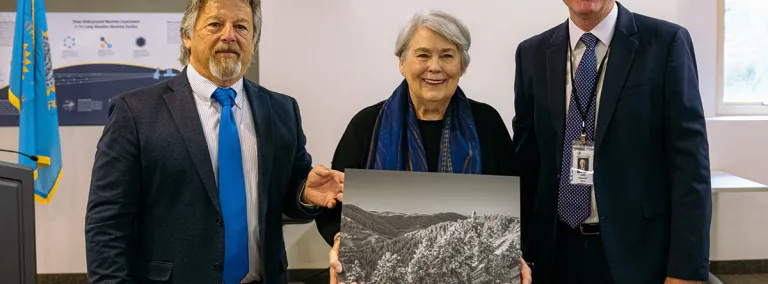Pat Lebrun retires from SDSTA Board
Charter Board member remains a strong advocate for science in South Dakota
In 2004, Pat Lebrun received an unexpected phone call from then-Governor Rounds’ office telling her that she was going to be appointed to the newly formed South Dakota Science and Technology Authority (SDSTA) Board. That appointment set her on a challenging course: figure out a way to bring a world-class research facility to South Dakota and build it in a former gold mine.
“I was selected because I was a strong advocate for science and research—not because I know anything about science,” Lebrun said. “I didn’t have much awareness about the project other than that the state was interested in turning Homestake into an underground laboratory."
Lebrun had been serving on the South Dakota Board of Regents for 18 years when appointed to the SDSTA Board and, for 18 more, was a driving force behind the creation of the Sanford Underground Research Facility (SURF). “That’s a cumulative 36 years,” she said. “Wow!”
On Sept. 22, Lebrun retired from the SDSTA Board, saying she was honored to have played a role in bringing SURF to South Dakota.
At the recent SDSTA Board meeting, Casey Peterson, chair of the Board, thanked Lebrun for her dedication to the Board and her commitment to SURF. “Pat, we appreciate your service and hard work. We appreciate everything you’ve done over your many years of service. In our hearts, we give a big ‘thank you.’”
Lebrun’s passion for science began long before she was tapped to serve on the SDSTA Board. A member of the South Dakota Board of Regents from 1987 through 2005, she had touted the value of building science research within the state and around the country.
“Research is so important to economic development and to the intellectual capital of South Dakota,” she said.
Mike Headley, executive director of the SDSTA, pointed to Lebrun’s contributions to SURF and her contributions to education in general.
“Pat has an incredibly strong background in higher education and has been a strong proponent for science for decades,” Headley said. “She has also been a huge proponent for the K-12 education part of our mission.”
“She was instrumental in helping to develop strong partnerships with the universities. And the formation of the physics PhD program in the state has been a result of those partnerships. She has pushed us to do whatever we can to work with universities in the state for their benefit and ours,” he continued. “Today, we've got 29 research groups at SURF and 24 include members from South Dakota universities. That’s a direct result of her leadership.”
For many, the idea of building a research facility from scratch would seem daunting. Not so for Lebrun, who, along with Peterson, is a charter member of the Board.
“We had nothing to begin with,” she said. “No policies, no procedures. No model to tell us how you build a laboratory like the one we have now. But we didn’t focus on that. We were basically wondering, ‘How do we get this done? How can we get this lab to South Dakota? How do we make this work?’ We were building a ship without any instructions. So, basically, we started by putting one foot in front of the other—week after week after week.”
Despite her confidence in the project’s success, Lebrun was no Pollyanna.
“We knew there were problems. We knew there were obstacles,” she said. “But most of us on the Board are not the kind of people who think things can’t get done. We think that if we get working hard enough and find the right people, it will happen.”
And it did—with a lot of hard work and significant support from the State Legislature and a generous donation from South Dakota businessman and philanthropist T. Denny Sanford.
“The support from the state was amazing,” Lebrun said. “Gov. Rounds was instrumental in making this happen. He really believed it could happen, and so we believed it could happen. We didn’t know how to do it, so we found the right people.”
And there were many people who helped.
“It was a lot of people with their shoulders to the wheel. It was the Governor, the Legislature, the Board members, the scientists, and the employees,” she said. “It was all these people who were committed to making it work. This is how you make things happen.”
As she reflects on her many years—and adventures—Lebrun emphasized that this is just the beginning.
“It’s a very exciting project and long-lasting thing,” she said. She paused then added, “A while ago I was at a conference in Washington D.C., and I was going through an exhibit hall. I looked up at a banner and it read, ‘Our greatest responsibility is to be good ancestors—Jonas Salk.’”
She smiled again, then added, “I guess you can call us the ancestors.”
